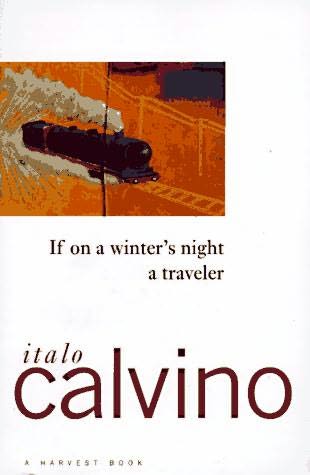Blog by Natalya Gornopolskaya
“If on a winter’s night a traveler” by Italo Calvino: 9-12
The Reader is bound for Japan. Upon his arrival he is stopped by security guards that confiscate his novel based on the grounds that it is banned. The Reader then meets a woman who resembles Lotaria; she offers him an escape route via taxi. She and the reader notice there are two more taxis following their taxi. At first they are stopped by the first taxi and arrested by cops along with their driver. They are then stopped by another taxi and get arrested once again by even more cops who also arrest the cops they were with. The woman he has met takes on a large variety of names. All of these elements serve to reinforce the theme of schism within the country. The reader is then taken to a prison where he sees the woman once again working as a technician. Turns out this woman is a fraud who wears several disguises while playing both sides of the schism. She leads the reader to a brand new novel called “Around an empty grave” by Calixto Bandera. This new novel is about a young boy whose ill reputed father has just passed away without ever telling him the truth about his mother. The boy goes in search of answers meeting various women along with their daughters who all have very similar features. At the end the boy discovers his father’s fate, the identity of his mother and that he must kill a man in order to fulfil his true destiny. In chapter ten, the Reader has successfully made his way out of prison by agreeing to undertake a very dangerous mission. The Reader now finds himself in Ircania with the Director General of the State Police Archives. The Reader was brought here to find the source of books that were being banned. The Director spoke of Marana and how they couldn’t decipher him because he was not mad, just simply desperate over the bet he lost to Ludmilla. This enraged Marana to the point at which he spread his confusion of titles, authors, and translations so that Ludmilla would realize his presence in her reading. The Director allowed Marana to escape thereby losing his trail, but allowing the rampancy of his work. The Director proceeds by offering the reader a brand new manuscript by the banned author Anatoly Anatolin called “What story down there awaits its end”. The Reader meets the author in secrecy to retrieve the manuscript, only to receive fragments once again as the pages are swept away by an icy wind. This next novel is about a man who has done something that caused the world to erase itself into oblivion. All the man can wish for now is to be alone with his good friend Franziska so they can go to a café and listen to an orchestra. Chapter eleven brings the reader into a library full of many other readers. Each reader comments on their own personal views towards reading. The Reader shows a list of all the books he’s encountered thus far to the librarian, only to find that not one is available. Looking at the list again it reads “If on a winter’s night a traveler, outside the town of Malbork, leaning from the steep slope without fear wind or vertigo, looks down in the gathering shadow in a network of lines that enlace, in a network of lines that intersect, on the carpet of leaves illuminated by the moon around an empty grave- What story down there awaits it’s end?” The other readers think that those are not titles, but the beginning of a story, a story which must not have a beginning and an end. One reader remarks that stories always end in two ways; with the hero and heroine succeeding and getting married or otherwise they both die. The Reader then decides to marry Ludmilla. At the end they share a bed as the Reader finishes If on a winter’s night a traveler by Italo Calvino.” Overall this story communicates the message that a powerful story is one limitless in conventions.
The blog for SUNY Binghamton's Spring'09 COLI 214B 02 Literature and Society Class. Chapter summaries, analyses and discussion of prescribed texts written by students.
Sunday, March 8, 2009
Subscribe to:
Post Comments (Atom)






No comments:
Post a Comment